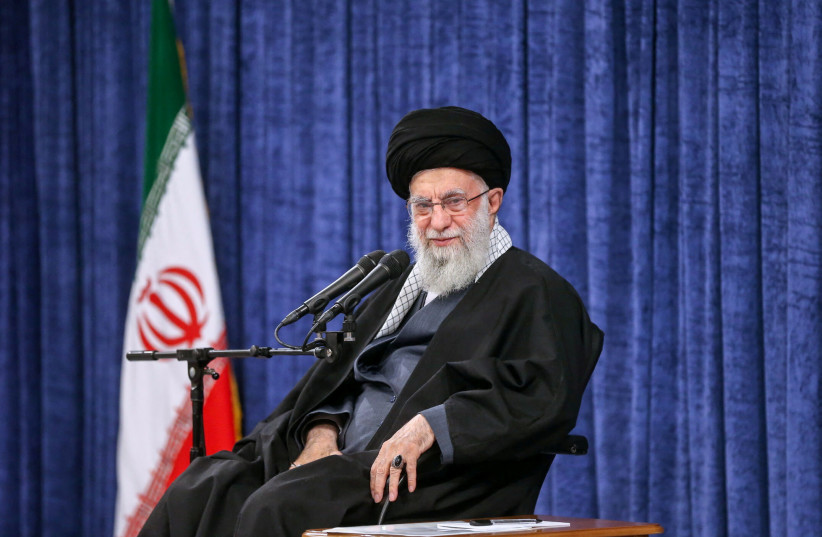A classic ploy: Iran feigns interest in deal as it edges towards nuclear capability
On Tuesday, Iran’s supreme leader opened the door for renewed negotiations with the United States over the Islamic Republic’s nuclear program, telling the new government in Tehran that there was “no harm” in engaging with its “enemy.”
Of course he said that – the United States has parked two aircraft carriers, multiple navy destroyers and several fighter jets squadrons right outside Khamenei’s front door. What better way to get the Americans to decrease the pressure, pull back its forces, and scale down tensions than to say that Iran is willing to hold negotiations about its nuclear program? This is a classic and obvious Iranian ploy.
Just look at what Iran has done in the past couple of months. In direct violation of its previous commitments, Iran has begun to rapidly expand its enrichment capacity at the Fordow nuclear facility by adding eight cascades, or clusters, of IR-6 centrifuges. Fordow is one of two places where Iran enriches uranium at levels of up to 60%, just a jump away from military-grade uranium, which needs to be enriched to 90% and more.
US assessments now are that Iran is just one or two weeks away from having enough fissionable material for a nuclear weapon. It is a simple decision at this point to simply move up the dial and enrich uranium to higher levels. American intelligence agencies, two top administration officials said last month, were closely tracking Iran after they noticed that officials in Tehran have started speaking more about what it would be like to obtain nuclear weapons.
The Iranian strategy is clear, and has been clear for more than two decades. They have done everything to reach the stage that they are at now – not yet cross the threshold, but be exactly at the threshold. They want to be considered a nuclear power without yet having to pay the international price – sanctions, economic isolation, and potential military attacks – if they were to break out, enrich uranium to military-grade levels, and build a bomb.

This is partially why Iran has moved so slowly with its program over the years. It is true that it encountered significant Israeli and American efforts to undermine it – covert operations, sanctions, and straight up diplomacy – but it also did not want to cross a red line that it knew it would not be able to walk back. It wanted, as a strategy, to line up all the necessary ingredients for a device, have them ready, and then when the time was right – due to distractions around the world or something else – be able to make the transition as quickly as possible at the lowest possible price.
Iran is stalling for time
AND THIS is exactly why Khamenei is throwing out now the option of renewed negotiations with the US over his country’s nuclear program. He doesn’t want a deal. On the contrary – what he wants is to make it through the end of US President Joe Biden’s term in office without the US feeling that it has to do something against Iran, either covertly, overtly, or diplomatically. This is simply a way to stall for time until it becomes clear who the next president will be – Kamala Harris or Donald Trump – and then the Iranians will shift gears once again based on who moves into the Oval Office.
How do we know this? Because this is exactly how they have always operated. Iran plays a long game that is about surviving as a regime while at the same time getting as close as they can to a bomb.
The world knows this but has decided until now to turn a blind eye. What the last 11 months of the war in Gaza though have showed us though is that Iran is not a problem that simply goes away, it gets bigger, stronger, and more dangerous. Just look at where we were 11 months ago: Israel’s general intelligence assessment then was that while Iran was the financier and suppliers of weapons to Hamas, Hezbollah and the Houthis (as well as others), the IDF could deal with each of these enemies independently. What it has learned since April, is that all of these actors are really one enemy.
Israel has been blamed over the years with killing multiple top Iranian officials including the country’s top nuclear scientist. But when it reportedly did that up until this war, it did not have to worry about direct Iranian retaliation. Today, direct retaliation is the new working assessment. Israel needs to assume that when it is in conflict with one actor in the axis, it will almost always lead to conflict with the entire axis.
This is a dramatic change for the IDF. It is already impacting Israeli force posture, Israeli society, the economy, and, of course, the decisions that the government makes when it comes to the continuation of the war in the South and the North.
One of the most dangerous moves that Israel and the West can make right now though is to turn a blind eye to what is happening in Iran. Distractions like the Gaza war, an uptick in violence in the West Bank, the US presidential elections and, as well, the escalation with Hezbollah, all serve Khamenei’s main goal of moving closer to a bomb while growing stronger at the same time.
The clock towards a real reckoning with Iran is ticking down. The question is whether there will be sufficient political will in Jerusalem and Washington to do what will be needed.
The writer is a senior fellow at the Jewish People Policy Institute (JPPI) and a former editor-in-chief of The Jerusalem Post.





Comments are closed.